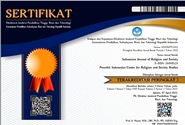Tantangan Bagi Penyandang Disabilitas Penglihatan dalam Mengakses Pekerjaan
Abstract
Keywords
Full Text:
PDFReferences
Achwan, R. (2014). Sosiologi Ekonomi di Indonesia. Jakarta: Universitas Indonesia.
Anggorowati, N. (2017). Perspektif Disabilitas Pembuat Kebijakan dalam Mendorong Perda Perlindungan Hak-Hak Disabilitas di Kabupaten Sleman. Universitas Gajah Mada.
Arthur, O. (2013). Penyandang Disabilitas. In Vulnerable Group: Kajian dan Mekanisme Perlindungannya. Jakarta.
Bengisu, M., Izbırak, G., & Mackieh, A. (2008). Work-Related Challenges for Individuals who are Visually Impaired in Turkey. Journal of Visual Impairment & Blindness, 102(5), 284–294. https://doi.org/10.1177/0145482x0810200504
Bos, A. E. R., Pryor, J. B., Reeder, G. D., & Stutterheim, S. E. (2013). Stigma: Advances in Theory and Research. Basic and Applied Social Psychology, 35(1), 1–9. https://doi.org/10.1080/01973533.2012.746147
Brown & Lerita M. Coleman. (2006). The Disability studies. New York: Routletge.
Butler, S., Crudden, A., & Sansing, W. (2005). Overcoming barriers to employment: Strategies of rehabilitation providers. Journal of Visual Impairment & Blindness ( …, 99(6), 1–20. Retrieved from http://www.afb.org/jvib/JVIB990602.asp
Cimarolli, V. R., & Wang, S. (2006). Differences in social support among employed and unemployed adults who are visually impaired. Journal of Visual Impairment & Blindness (JVIB), 100(9), 545–556. Retrieved from http://www.afb.org/jvib/jvib000905.asp
Coffey, M., Coufopoulos, A., & Kinghorn, K. (2014). Barriers to employment for visually impaired women. International Journal of Workplace Health Management, 7(3), 171–185. https://doi.org/10.1108/IJWHM-06-2013-0022
Creswell. (2002). Reseach Design: Qualitative, quantitative, and mixt method approach (second edi). Lodon.
Crudden. (2002). Employment after Vision Loss. Journal of Visual Impairment & Blindness (JVIB), 96(9), 615–621.
Donnell, W. O. (2014). An Analysis of Employment Barriers Facing Blind People. 5(21).
Douglas, S. (2013). Walden University DIssertation (Walden University). https://doi.org/10.1111/j.1467-8616.2008.00521.x Malik,
Goertz, Y. H. H., van Lierop, B. A. G., Houkes, I., & Nijhuis, F. J. N. (2019). Factors Related to the Employment of Visually Impaired Persons: A Systematic Literature Review. Journal of Visual Impairment & Blindness, 104(7), 404–418. https://doi.org/10.1177/0145482x1010400704
Goffman, E. (1963). Stigma:Note of the Management of spoiled identity.
Grow, S. J. La. (2004). Factors that Affect the Employment Status of Working-Age Adults with Visual Impairments in New Zealand. 98(9), 1–29.
InfoDatin. (2013). Gangguan Penglihatan dan Kebutaan Republik Indonesia. In Pusat Data dan Informasi Kementerian Kesehatan RI. Retrieved from file:///C:/Users/tes/Downloads/infodatin-penglihatan (1).pdf
Irwanto, Kasim, E. R., Lusli, M., & Siradj, O. (2010). Analisis Situasi Penyandang Disabilitas Di Indonesia: Sebuah Desk-Review. Retrieved from https://www.ilo.org/wcmsp5/groups/public/---asia/---ro-bangkok/---ilo-jakarta/documents/publication/wcms_160340.pdf
Isneningtyas. (2016). Dangkalnya kewarganegaraan inklusif. universitas gajah mada.
J.Pierson. (2009). tackling Social Exclusion. In Taylor & Francis Group (second). London & New York: Routledge.
Kaye, H. S., Jans, L. H., & Jones, E. C. (2011). Why don’t employers hire and retain workers with disabilities? Journal of Occupational Rehabilitation, 21(4), 526–536. https://doi.org/10.1007/s10926-011-9302-8
Kirchner, C. E., Gerber, E. G., & Smith, B. C. (2008). Designed to Deter. American Journal of Preventive Medicine, 34(4), 349–352. https://doi.org/10.1016/j.amepre.2008.01.005
Lee, I. S., & Park, S. K. (2008). Employment Status and Predictors Among People with Visual Impairments in Sout ... 102(3), 147.
Levitas. (2005). The inclusive society. In Liberty, equality, fraternity (Second edi). https://doi.org/10.2307/j.ctt9qgkg5.11
Levitas, et. a. (2007). The Multidimensional analysis of social exclusion. https://doi.org/10.1016/0003-2697(74)90161-4
LPEM FEB UI. (2017). Memetakan Penyandang Disabilitas (Pd) Di Pasar Tenaga Kerja Indonesia. Retrieved from www.ifrro.org
Mcneil, J. C. (2015). Workplace Discrimination and Visual Impairment: an Analysis of Eeoc Charges and Resolutions.
Nagle, K. M. (2001). Transition to employment and community life for youths with visual impairments: Current status and future directions. Journal of Visual Impairment & Blindness, 95(12), 725–738.
Naraine, M. D., & Lindsay, P. H. (2011). Social inclusion of employees who are blind or low vision. Disability and Society, 26(4), 389–403. https://doi.org/10.1080/09687599.2011.567790
Nee. (2003). New institutionalism, economic and sociological.
O’Day, B. (1999). Employment barriers for people with visual impairments. Journal of Visual Impairment & Blindness, 93(10), 627–642.
Oliver, M. (1996). Understanding Disability. From Theory to Practice (Book). The Journal of Sociology and Social Welfare, 23(3), 118–119. https://doi.org/10.1111/1467-9566.ep10934325
Pavey, S., Douglas, G., & Corcoran, C. (2008). Transition into adulthood and work — findings from Network 1000. The British Journal of Visual Impairment, 26(2), 202–216. https://doi.org/10.1177/0264619607088283
Sen, A. (2000). The Task of Evaluation and Assessment. In The Social Exclusion: Concept, Application, And Scrutiny.
Shaw, A., Gold, D., & Wolffe, K. (2007). Employment-related Experiences of Youths who are Visually Impaired: How are these Youths Faring? Journal of Visual Impairment & Blindness, 101(1), 7–21. https://doi.org/10.1177/0145482x0710100103
Stevens, M. E., Parsons, J. A., Read, S. E., & Nixon, S. A. (2017). The conceptualization of stigma within a rehabilitation framework using HIV as an example. Disability and Rehabilitation, 41(2), 235–243. https://doi.org/10.1080/09638288.2017.1385099
Tobias, E. I. (2017). Disability and Social Exclusion : Experiences of Individuals with Visual Impairments in the Oshikoto and Oshana Regions of Namibia. Deoartement If Psycology, 29(1), 22–43. https://doi.org/10.1177/0971333616689203
Wolffe, K., & Candela, T. (2002). Expanding the labor pool: Recruiting, hiring, and retaining workers with visual impairments. Employment Relations Today, 29(3), 59–68. https://doi.org/10.1002/ert.10050
Yang-Handy. (2013). Preparing Visually Impaired People in The Ohilippines for Mainstreaming Employment: Perception of The Impact of ICT Accessibility. University of Massachussetts.
DOI: https://doi.org/10.36256/ijrs.v1i1.25
Refbacks
- There are currently no refbacks.
Copyright (c) 2019 Indonesian Journal of Religion and Society

This work is licensed under a Creative Commons Attribution-NonCommercial 4.0 International License.
Indonesian Journal of Religion and Society (IJRS) Is Indexed By:

Indonesian Journal of Religion and Society (IJRS) is distribute under Creative Commons Attribution-NonCommercial 4.0 International License.













